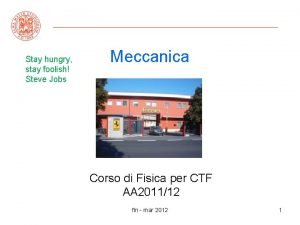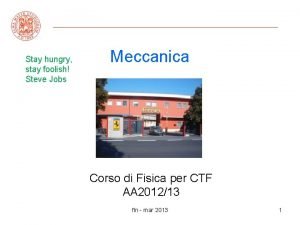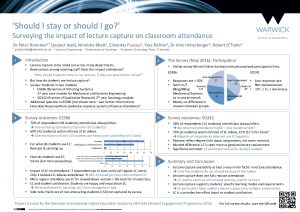Should I Stay Or Should I Go The









































- Slides: 41

Should I Stay Or Should I Go? The importance of electricity rate design for household defection from the power grid WILL GORMAN, STEPHEN JARVIS, AND DUNCAN CALLAWAY USAEE CONFERENCE | DENVER, CO | NOVEMBER 5 TH, 2019 11/22/2020 WILL GORMAN | USAEE | UC BERKELEY 1

Agenda Introduction and Motivation Economic Theory Methods Results 11/22/2020 WILL GORMAN | LAB MEETING | UC BERKELEY 2

Introduction and Motivation Solar PV and storage prices have been declining Solar costs have declined ~70% since 2008 Storage costs projected to decline Sources: LBNL Tracking the Sun VIII (2018) Sources: NYSERDA (2018) 11/22/2020 WILL GORMAN | USAEE | UC BERKELEY 3

Introduction and Motivation Grid defection vs. load defection Load Defection: customers who supplant their power supply with on-site generation while remaining connected to the grid Grid Defection: customers who forfeit their connection to the grid entirely, regardless of their final state of electricity consumption or production Will people defect? Grid Defection Load Defection k. Wh load k. Wh Storage Device 11/22/2020 WILL GORMAN | LAB MEETING | UC BERKELEY 4

Introduction and Motivation Context with prior research Developing world off-grid systems ◦ Off-grid systems can be competitive with transmission/distribution grid extension ◦ (Chakrabarti & Chakrabarti, 2002); (Schnitzer, et al, 2014); (Ravindra & Iyer, 2014) Developed world grid defection ◦ Small but growing literature ◦ Rely on average electricity rates, average solar profiles, and average load profiles ◦ (RMI, 2014); (Khalilpour, et al, 2015); (Hanser, et al, 2017); (Hittinger et al, 2017) Utility rate design ◦ Economic literature focused on efficient rate design with marginal and fixed charges ◦ (Borenstein, 2016); (Borenstein, 2019); (Friedman, 2011); (Bonbright, 1961); 11/22/2020 WILL GORMAN | LAB MEETING | UC BERKELEY 5

Introduction and Motivation We assess three key factors that could influence the decision to defect from the grid How do demand differences between customers impact the defection decision? How does rate design interact with these demand differences to shift private economics of defection? How important are customer preferences for electric reliability? 11/22/2020 WILL GORMAN | USAEE | UC BERKELEY 6

Agenda Introduction and Motivation Economic Theory Methods Results 11/22/2020 WILL GORMAN | LAB MEETING | UC BERKELEY 7

Customer cost of grid electricity Comments: • An electric utility supplies electricity to two customers with either low or high demand that is perfectly inelastic Price HIGH FIXED CHARGE PER CUSTOMER DEMAND 1 DEMAND 2 • LOW FIXED CHARGE PER CUSTOMER AVERAGE COST (low fixed charge) The utility has some fixed costs incurred per customer, and some constant marginal costs incurred per unit of electricity consumed by each customer AVERAGE COST (high fixed charge) Quantity 11/22/2020 WILL GORMAN | LAB MEETING | UC BERKELEY 8

Customers can install solar+storage too Price HIGH FIXED CHARGE DEMAND LOW FIXED CHARGE 1 DEMAND Comments: • Customers can also defect by installing a solar/storage system 2 • Current utility rates have a relatively low fixed charge and high variable charge • A new alternative utility rate structure is adopted with the aim of cutting variable rates to more properly reflect the utility’s true underlying costs. AVERAGE COST SOLAR+STORAGE AVERAGE COST GRID Quantity 11/22/2020 WILL GORMAN | LAB MEETING | UC BERKELEY 9

Agenda Introduction and Motivation Economic Theory Methods ◦ Solar + Battery Optimization Model ◦ Data Results 11/22/2020 WILL GORMAN | LAB MEETING | UC BERKELEY 10

Methods Use a solar + storage optimization model Optimization model ◦ Minimize cost of a storage + solar system given a variety of system constraints ◦ Run simulations with varying costs for solar/storage ◦ Consider two reliability scenarios 1. 2. “Perfect” reliability “Flexible” reliability Model three consumer decisions: 1. Remain grid connected 2. Install solar system (i. e. load defection) 3. Install solar + storage system (i. e. grid defection) 11/22/2020 WILL GORMAN | USAEE | UC BERKELEY 11

Methods Data collection across the US Load data Solar data 9 years historical data 11/22/2020 Include low, base, and high demand cases WILL GORMAN | USAEE | UC BERKELEY 12

Results Setting variable rates to market prices increases fixed charges 2016 Variable Rates Wholesale market prices are much more uniform than current variable retail rate suggests Private Marginal Cost Current 2016 Fixed Rates Current Fixed charge would need to increase substantially if regulators force variable charges to equal wholesale prices (i. e. private marginal costs) 11/22/2020 Private Marginal Cost Note: The range of variable rates in the PMC scenario (top right graph) is 2. 2 – 7. 6 cent/k. Wh WILL GORMAN | USAEE | UC BERKELEY 13

Agenda Introduction and Motivation Economic Theory Methods Results 11/22/2020 WILL GORMAN | LAB MEETING | UC BERKELEY 14

Results The potential for defection under perfect reliability Perfect reliability case - Limited potential for grid defection - Low costs for solar makes load defection attractive option in most of U. S. - Rate design change to PMC rates eliminates load defection Current Rates Low load Base load High load Private Marginal Cost Rates Low load Base load High load Low cost assumptions: $1. 2/W PV; $100/k. Wh storage 11/22/2020 WILL GORMAN | USAEE | UC BERKELEY 15

Results The potential for defection under flexible reliability Current Rates Low load Private Marginal Cost Rates Low load Base load High load Flexible reliability case -Still limited potential for grid defection, but rate effects are more striking -Defection becomes more likely for low load customers Low cost assumptions: $1. 2/W PV; $100/k. Wh storage 11/22/2020 WILL GORMAN | USAEE | UC BERKELEY 16

Conclusions Grid defection, though unlikely to impact many regions, is a possibility for certain locations in the United States Customer demand plays a critical role in grid defection decision Fixed charges could significantly limit load defection while creating a larger private incentive for grid defection The choice of reliability level is a key open question: how will customers respond to the option to purchase different levels of reliability? 11/22/2020 WILL GORMAN | USAEE | UC BERKELEY 17

Thank you for your time Happy to take questions and feedback Contact: Will. Gorman 5@gmail. com 11/22/2020 WILL GORMAN | USAEE | UC BERKELEY 18

Backup Slides 11/22/2020 WILL GORMAN | USAEE | UC BERKELEY 19

Results The potential for grid defection by household A more sophisticated analysis where we use the RECS household survey data Scenario Technology Cost Rate Structure Reliability Current base Low future Current base Current PMC Current base PMC Perfect Flexible Households (millions) Utility Load Service Defection Grid Defection 126 134 80 80 133 123 0. 0 0. 3 1. 4 9. 4 8. 7 0. 0 55 54 0. 0

Results Reliability effects Percentage of load shed by month in “flexible” vs. “perfect” reliability cases Comments: • Occurs during the winter time when solar output is low and demand for lighting and heating is high • 11/22/2020 WILL GORMAN | USAEE | UC BERKELEY Duration of time households were held at the 300 W minimum exceeded 7 days for none of the grid defection households under current rates and for 2 million out of 10 million grid defection households under the PMC rate structure. 21

Results System Sizing Two significant drivers of system sizing: (1) Customer size heterogeneity Storage Sizing (2) Reliability ◦ Energy reduced by 1% ◦ Mean solar size reduced by 43% ◦ Mean storage size reduced by 59% Solar Sizing 11/22/2020 WILL GORMAN | LAB MEETING | UC BERKELEY 22

Results The potential for grid defection Considering low case costs (100% reliability) System Cost vs. Current Rates System Cost vs. PMC Rates Grid defection line 11/22/2020 WILL GORMAN | LAB MEETING | UC BERKELEY Grid defection line 23

Results The potential for grid defection Considering low case costs (100% reliability) System Cost vs. Current Rates Grid defection line System Cost vs. PMC Rates Grid defection line

Load Model Climate Regions 11/22/2020 WILL GORMAN | USAEE | UC BERKELEY 25

Load Model Climate Regions 11/22/2020 WILL GORMAN | USAEE | UC BERKELEY 26

Economic Theory Rate design can impact grid defection decision Two mechanisms for grid defection 1. Desire for different utility product 2. Cost parity Illustration of grid defection under varying two-part rate schemes ◦ Inefficient rate design 11/22/2020 WILL GORMAN | USAEE | UC BERKELEY 27

Economic Theory Will customers act rationally? My approach relies on a rational actor framework for decision making ◦ How would customers behave to minimize their own electricity costs? ◦ Requires a number of assumptions regarding consumer behavior The choice to defect from the grid is much more complicated ◦ Potentially limiting defection: ◦ High transaction costs ◦ Uncertainty regarding reliability ◦ Potentially promoting defection: ◦ Desire for self-reliance ◦ Frustration with monopoly power ◦ Desire to be fully “green” Although important effects, they are out of scope for this project 11/22/2020 WILL GORMAN | USAEE | UC BERKELEY 28

Economic Theory The decision to defect Compare the cost of electricity for three scenarios: 1. Grid supplied electricity 2. Load defection: install solar to offset annual electricity consumption while still getting grid power at night time. 3. Grid defection: install solar + storage to replace electricity from grid entirely 11/22/2020 WILL GORMAN | USAEE | UC BERKELEY 29

Methods Solar + Storage Optimization Model Optimization model ◦ Objective function minimizes cost of a storage + solar system given a variety of constraints (discussed on next slide). Run simulations with varying costs for solar/storage to calculate costs of offgrid system 11/22/2020 WILL GORMAN | USAEE | UC BERKELEY 30

Methods Battery Constraints System Constraints 11/22/2020 WILL GORMAN | USAEE | UC BERKELEY 31

Introduction and Motivation Drivers of distributed battery systems Can’t utility-scale storage provide all the benefits of distributed storage at a cheaper price? Customers may be motivated to install distributed PV/battery systems for several reasons: ◦ Improved reliability by serving as backup power (critical loads / infrastructure) ◦ Reduced electricity bills, due to favorable rates (demand charge management and TOU management) ◦ Reduced electricity bills, due to subsidies (California SGIP) Sources: GTM Research (2018) 11/22/2020 WILL GORMAN | USAEE | UC BERKELEY 32

Economic Theory Natural monopoly regulation Natural monopolies arise when total costs are lower if one firm supplies the entire market ◦ Economies of scale ◦ Average cost > marginal cost (i. e. large fixed costs) Monopolies, however, will charge too high a price if left alone Regulated industry If monopoly only recoup marginal costs, it won’t be able to remain solvent 11/22/2020 WILL GORMAN | USAEE | UC BERKELEY 33

Economic Theory How to recover the fixed costs? Ramsey pricing: markup inelastically-demanded goods more ◦ Problem of fairness Multi-part tariff with variable cost (ideally at MC) and fixed charges Declining and inclining block pricing Direct government subsidies Ramsey Pricing Multi-Part Tariff Higher Price Social Marginal Cost Declining 11/22/2020 Inelastic User Inclining Variable + Fixed charge Social Marginal Cost Elastic user Deadweight loss Declining/Inclining Block Rates Variable charge only WILL GORMAN | USAEE | UC BERKELEY 34

Methods Cost Model and Data Financial Category Interest Rates (Ipv and Is) Lifetime (Lpv and Ls) Efficiency Optimization Capital Costs (Kpv and Ks) Load-based Capital Costs 11/22/2020 Assumptions Used Both at 4% real interest rate Solar: 25 years Storage: 10 years Inverter: 10 years Storage: 85% roundtrip Solar: High - $1. 2/Wdc; Low - $0. 6/Wdc Storage: High - $400/k. Wh; Low - $100/k. Wh Inverter: High - $0. 3/Wac; Low - $0. 15/Wac Soft Cost + BOS: High - $1/Wac; Low - $0. 50/Wac O&M: $12/k. Wac-year WILL GORMAN | USAEE | UC BERKELEY 35

Methods Data Collection Data Type Current Source Hourly U. S. Solar Data • • NREL’s National Solar Radiation Database (NSRDB) provides historical weather data. (2008 -2016) Combine with System Advisory Model Simulations Hourly U. S. Load Data • • Open. EI load datasets (TMY 3) Have high, base, and low cases Current Utility Rate Data • Open. EI Utility Rate Database provides rate structure information for over 3, 700 U. S. utilities (updated annually) Residential Revenues from EIA 861 • 11/22/2020 WILL GORMAN | USAEE | UC BERKELEY 36

Methods Average Solar Data 11/22/2020 WILL GORMAN | USAEE | UC BERKELEY 37

Methods Average Solar Data 11/22/2020 WILL GORMAN | USAEE | UC BERKELEY 38

Results Flexible reliability (Base cost) System Cost vs. Current Rates Load case: Low Load case: Base Load case: High System Cost vs. PMC Rates Load case: Low Load case: Base Load case: High Base cost assumptions: $2. 5/W PV; $400/k. Wh storage 11/22/2020 WILL GORMAN | LAB MEETING | UC BERKELEY WILL GORMAN | USAEE | UC BERKELEY 39

Results Perfect reliability (Base cost) System Cost vs. Current Rates Load case: Low Load case: Base Load case: High System Cost vs. PMC Rates Load case: Low Load case: Base Load case: High Base cost assumptions: $2. 5/W PV; $400/k. Wh storage 11/22/2020 WILL GORMAN | LAB MEETING | UC BERKELEY WILL GORMAN | USAEE | UC BERKELEY 40

Results Solar + Storage System Costs System Cost: 100% reliability Load case: Low System Cost: 99% reliability Load case: Low Costs are driven by two key things: (1) solar radiation in each region Load case: Base Load case: High 11/22/2020 Load case: Base Load case: High WILL GORMAN | USAEE | UC BERKELEY (2) simulated load profiles whose attributes vary by climate region The southeast, for instance, is the only region with modeled electric heating which is one reason for high costs (larger electric load) 41
 My wish for you is that life becomes
My wish for you is that life becomes Stay hungry stay foolish steve jobs summary
Stay hungry stay foolish steve jobs summary Good evening stay safe
Good evening stay safe Good morning stay safe images
Good morning stay safe images Where you go ill go
Where you go ill go So stay so stay 再知己
So stay so stay 再知己 Stay hungry stay foolish significato
Stay hungry stay foolish significato What does stay hungry stay foolish mean
What does stay hungry stay foolish mean To daffodils by robert herrick شرح
To daffodils by robert herrick شرح Giọng cùng tên là
Giọng cùng tên là Vẽ hình chiếu vuông góc của vật thể sau
Vẽ hình chiếu vuông góc của vật thể sau 101012 bằng
101012 bằng Chúa yêu trần thế alleluia
Chúa yêu trần thế alleluia Khi nào hổ mẹ dạy hổ con săn mồi
Khi nào hổ mẹ dạy hổ con săn mồi Gấu đi như thế nào
Gấu đi như thế nào Lời thề hippocrates
Lời thề hippocrates đại từ thay thế
đại từ thay thế Quá trình desamine hóa có thể tạo ra
Quá trình desamine hóa có thể tạo ra Cong thức tính động năng
Cong thức tính động năng Thế nào là mạng điện lắp đặt kiểu nổi
Thế nào là mạng điện lắp đặt kiểu nổi Các loại đột biến cấu trúc nhiễm sắc thể
Các loại đột biến cấu trúc nhiễm sắc thể Frameset trong html5
Frameset trong html5 Vẽ hình chiếu đứng bằng cạnh của vật thể
Vẽ hình chiếu đứng bằng cạnh của vật thể độ dài liên kết
độ dài liên kết Môn thể thao bắt đầu bằng từ đua
Môn thể thao bắt đầu bằng từ đua Khi nào hổ con có thể sống độc lập
Khi nào hổ con có thể sống độc lập Thang điểm glasgow
Thang điểm glasgow Thiếu nhi thế giới liên hoan
Thiếu nhi thế giới liên hoan điện thế nghỉ
điện thế nghỉ Một số thể thơ truyền thống
Một số thể thơ truyền thống Nguyên nhân của sự mỏi cơ sinh 8
Nguyên nhân của sự mỏi cơ sinh 8 Trời xanh đây là của chúng ta thể thơ
Trời xanh đây là của chúng ta thể thơ Số nguyên là gì
Số nguyên là gì Bổ thể
Bổ thể Tia chieu sa te
Tia chieu sa te Các châu lục và đại dương trên thế giới
Các châu lục và đại dương trên thế giới Thế nào là hệ số cao nhất
Thế nào là hệ số cao nhất Hệ hô hấp
Hệ hô hấp Tư thế ngồi viết
Tư thế ngồi viết Bàn tay mà dây bẩn
Bàn tay mà dây bẩn đặc điểm cơ thể của người tối cổ
đặc điểm cơ thể của người tối cổ Mật thư anh em như thể tay chân
Mật thư anh em như thể tay chân

































































